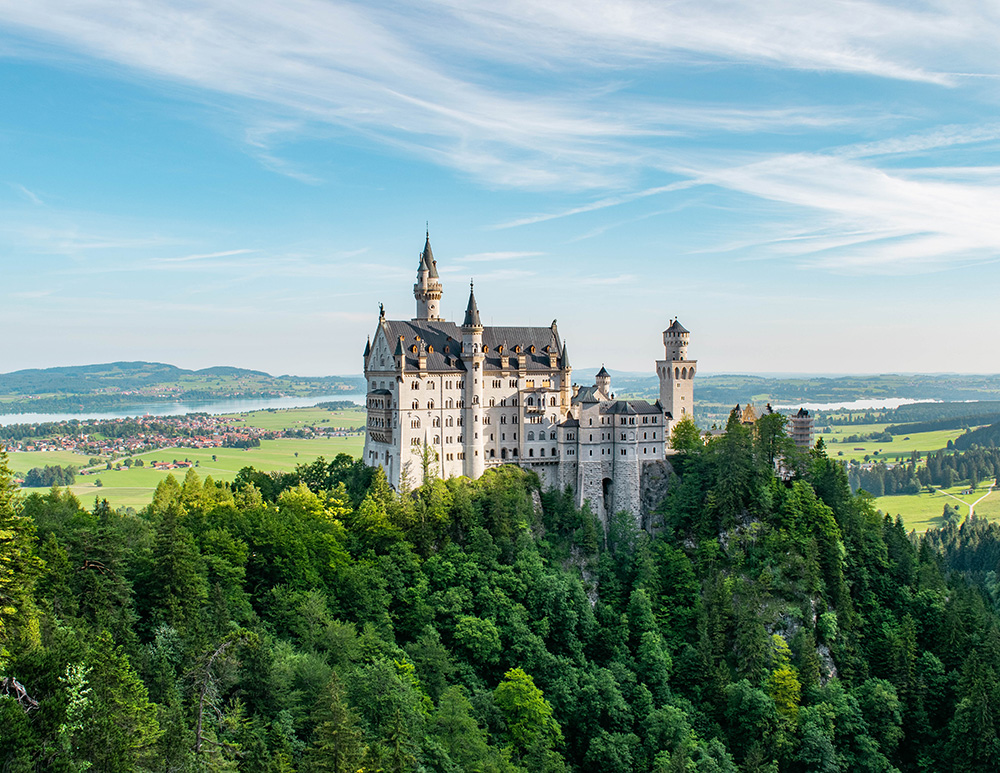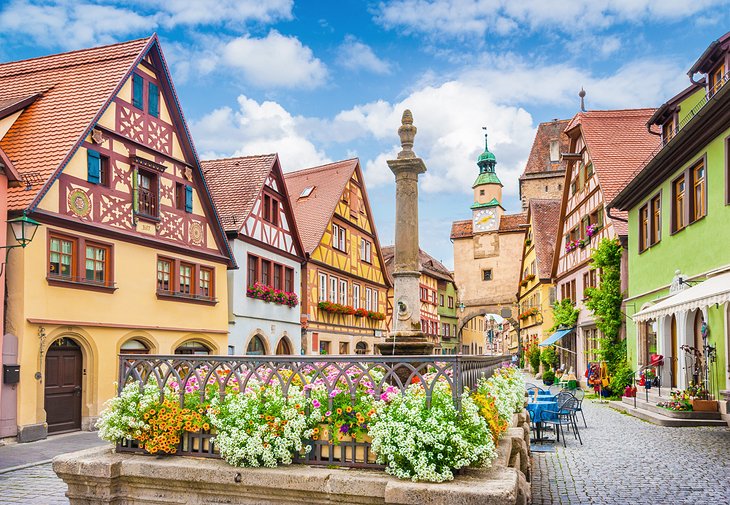DELVE INTO GERMANY: TOP DESTINATIONS IN GERMANY
Time moves quickly on Germany’s fast highways. It is I, in fact, who is doing the soaring. Even when I’m travelling over 100 miles per hour in my BMW 745i, the ride is so smooth that it only feels like I’m going 60.
Audis and BMWs zoom by us like we’re not even there. Since some less-traveled German highways still do not have speed limits and the motorway is in excellent condition, I let the BMW do what it does best and pressed on with the gas.
Thank goodness my mother, who is riding shotgun, is paying attention to what’s going on outside the window and not the needle on the speedometer. The scenery is picture-perfect. The landscape is dominated by fertile farmland that has been stripped bare after harvest. Huge pieces of farm machinery are scattered throughout the fields, and farmers are working hard to get them ready for next year’s harvest.
The sun is shining brightly in the clean blue sky above. Having this exquisite automobile and being in Germany today couldn’t be better.
This technological marvel isn’t mine, alas. My German buddy Torsten owns the BMW and kindly let me and my mom borrow it for our girls’ road trip. However, this journey is unusual because we did not bring any maps. Our only map is the one on the car’s GPS system.
Torsten had wished us well and sent us on our way after giving us a brief driving instruction in the northern city of Hamburg. A woman’s voice, speaking in polished High German, directed our course through the crowded streets. Although I needed to review some language (the German I learnt while attending school in Austria came in helpful!), we were on our way out of the city within 45 minutes.
Our current goal is to spend five days traveling throughout Mecklenburg-Vorpommern, a state in Germany that was formerly a part of East Germany. We’ll be staying at castles during the trip.
Mecklenburg-West Pomerania has a relatively small population of 1.7 million despite being the sixth largest state in Germany. With its proximity to the Baltic Sea and plenty of lakes inland, this region is a popular vacation spot for Europeans. Despite its obvious beauty, surprisingly few Americans visit this region. This is also my first time in this part of the world, and I’m starting to wonder what took me so long to come here.
Schwerin, Germany, population 96,500, is our first stop. It is located around 70 miles (112 kilometers) east of Hamburg. The island castle in the midst of Lake Schwerin is the main attraction in Schwerin, the capital of Mecklenburg-Western Pomerania.

DISCOVER GERMANY: TRAVEL IDEAS IN GERMANY
Schwerin Castle is the epitome of a great castle, with its golden towers and lofty turrets. The fortress was transformed into a palace in the 16th and 17th centuries, when it served as the seat of the Grand Duchy of Mecklenburg-Schwerin. As we move from room to room, our guide recounts the lives of bygone aristocrats. American brains reel from millennia of history we were unaware of as we crane our necks to stare at ceiling murals.
We pause for lunch at Zum Stadtkrug, a local brew bar, to bring ourselves back to reality after a whirlwind of new information. Brewmaster Hans-Ulrich Trosien makes time to chat with us, walking us through the process of creating beer and providing us with samples of his robust black ale. After stuffing ourselves with hearty German fare, we return to our reliable BMW and drive to our very own castle, if only for a few days.
We got lost in the country and ended up 20 minutes outside of Schwerin at the end of a dirt road bordered with trees, but we found Schloss Basthorst in the end. Schloss Basthorst, like many East German castles, was abandoned for decades during communist administration. But now it’s been transformed into a chic boutique hotel.
Schloss Basthorst is more of a big manor than a castle, with its red brick and open-timbered halls and the aura of an attractive great old woman. A bunch of German businesspeople are staying here with my mother and I. The night is so lovely that instead of holding meetings inside, people are holding candlelit conversations in the backyard gardens, the sound of their conversation gently wafting up to our windows.
We go for Wismar, a Baltic Sea port town, first thing the following morning. Wismar, a Hanseatic town from 1259 and a UNESCO World Heritage site dating back to the 1220s. The Swedish troops took control of Wismar in 1632. Some locals have a Nordic appearance, there is an annual festival called Schwedenfest (Sweden in English), and some terms from the Swedish language are still in use today because the area was under Swedish authority for roughly 150 years.
Our day’s guides, Guenther Faust and Dallas Reese, teach me all this and more. I tag along with Guenther as he does his best to explain the history of the town in basic German that I can comprehend while Dallas, an English expat, and my mother explore the town on their own.

Our tour begins at the Church of Mary, whose tower soars to a lofty 262 feet (80 meters), and continues on to the ruins of St. George Cathedral, which was destroyed by American bombs but will be fully restored by 2010. However, my favorite place to visit is a nearby bakery. I’ve had a serious yearning for German pastries ever since we arrived, so the four of us sit around a tiny outdoor table and enjoy some tortes and Berliner while we speak and have a good time.
The moment has come to hit the road once more. After two hours on the road, during which we saw nothing but farms and little towns, we arrived at Schlosshotel Gutshaus Ludorf. The hotel, which was constructed in 1698 in the Danish brick renaissance style, enjoys a prime location on the western bank of the Müritz River. The manor, which was once a rundown hospital, has been lovingly renovated by Keril and Manfred Achtenhagen.
Several valuables, such as old ceiling murals hidden by paint, have been unearthed as a result of this work. The manor’s 23 rooms are all unique, with features like open-beamed ceilings and carved fireplaces. Our room rate, like that of many German hotels, includes a hearty continental breakfast. My mother is relieved to find that our hotel hosts, like most Germans we’ve met so far, are fluent in English.
Due to the abundance of lakes in the area, the Müritz Nature Reserve has earned the moniker “land of a thousand waters,” and Gutshaus Ludorfis is located directly across the street. As we go about the neighborhood in the afternoon, we encounter cyclists, hikers, and boaters enjoying the outdoors. We then set off to investigate Ludorf, a nearby settlement consisting of hardly more than fifty structures. A unique 14th-century octagonal church serves as the community’s focal point. I can travel the length of the church in fewer than twenty steps.
We leave for Waren, a lovely town that has completely reinvented itself since its communist era, later in the day. The cobblestone streets are lined with colorfully painted houses and hip cafes and boutiques. We have ice cream and sit in the sun to enjoy it. The Albanian waiter serving us clearly adores this region of Germany. The city of Waren has everything one needs to lead a comfortable life, and it’s a manageable size for strolling around.
After that, it’s only a 40-minute journey to Klink, where you may enjoy yourself on Lake Müritz. Although Tokon Sports often organizes outings for large groups, they graciously agree to take us on a speedboat tour of the lake. From this vantage point, the seaside village appears little, and the thrill of swiftly crossing the water is exhilarating.
The members of Tokon’s young staff may not have even been alive during the region’s communist rule. I love spending time with them because of the new perspective on life in their native country that they bring to the table.
They bring us to the spa and resort Schlosshotel Klink, a big, fantastical castle. This castle is more business-oriented, offering event space for weddings and conferences. With a view of the lake from the castle’s deck, we enjoy a meal of fresh fish. From up here, one may easily imagine themselves to be royalty.
Our final day is spent in Güstrow, a charming town of 31,000 on the Nebel River about an hour’s drive from our current location. Some areas have been lovingly renovated and modernized, while others remain in disrepair, waiting for owners with the will and resources to bring them back to life.
We begin our exploration of Güstrow with a stroll through the historic district before heading to the palace’s museum, Palace Güstrow. The dukes of Mecklenburg lived in this renaissance fortress, which was constructed in 1589. It was damaged during war and communist rule, but reconstruction began in 1963 and was finished in 1981.
The Schwebende Engel (Hovering Angel) by expressionist sculptor Ernst Barlach, installed in the city’s cathedral (a brick Gothic church erected between 1226 and 1335) in 1926 as a memorial to the casualties of World War I, is the most popular attraction there.

The Neubert sisters, our tour leaders, join us for lunch afterward. One grew up in West Germany and the other in East Germany, their lives forever divided by the Berlin Wall. After being separated for many years due to the Berlin Wall, the family was finally reunited when Germany was reunified.
When I return to Germany, I am always astounded by how much has changed. My mother and I are driving back to Hamburg when we pass a single German flag, measuring about 10 feet (3 meters), that is proudly displayed in a window. While citizens of many countries proudly show their flags, Germans have been hesitant to do so for fear of reviving memories of the country’s horrible Nazi past.
Nonetheless, it appears that Germany has now allowed itself to feel proud of its hard-fought achievements. Over the past few decades, a country with two distinct cultures and philosophies has been merged into a single, stronger nation.
And after spending the past week traveling around the villages of what was formerly East Germany, I can’t help but be proud of their achievements.




